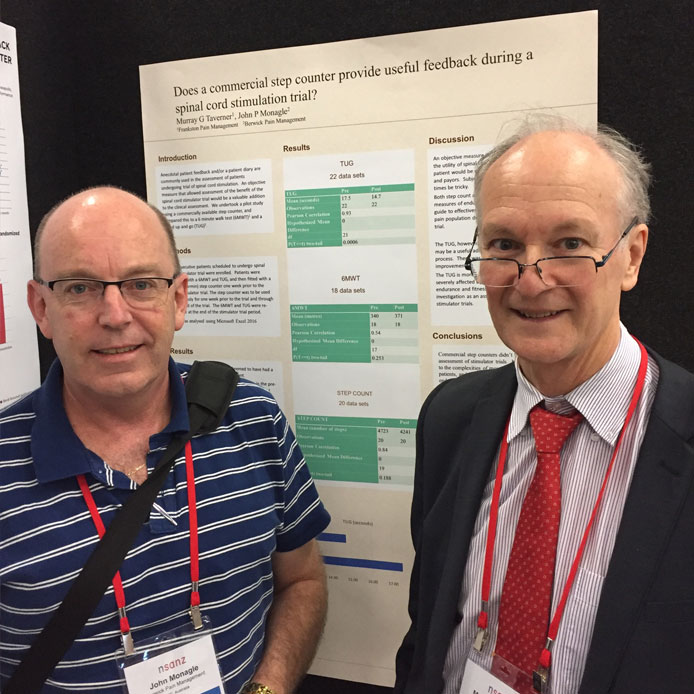Research
Why we do research
Pain management is a rapidly evolving field with new and more effective treatment methods constantly emerging.
Our research into spinal cord stimulation, neuromodulation, new medications and other pain management techniques enables us to give our patients the most advanced and efficient options for managing pain.
Our patients are often given the opportunity to take part in research projects. Let us know if this is something you may be interested in.


Past Studies
Patient recruitment completed
- An Open-Label, Non-Randomized Study Investigating the Coolio™ System (BXT-786 3.0 Device): A Novel Approach for Managing Knee Pain in Osteoarthritis through Cold Energy Regional Analgesic Block. BXT-786-KPM-02
- A Pilot, Non-Randomized, Open Label Study Of A Novel Device And Its Delivery System (BXT Focused Cold Therapy), Providing Cold Energy Regional Anesthetic Block For Knee Pain Management. BXT-786-TKA-01
- Safety and Efficacy of SX600 Administered by Lumbosacral Transforaminal Epidural Injection for Radicular Pain (SALIENT). Protocol: CLIN-0012-STA01-19
- Multicentre Study of Low Dose Targeted Drug Delivery (TDD) for Chronic Back Pain Patients who have Failed Spinal Cord Stimulation. GRS2018-006
- A Prospective Cord Stimulation in the treatment of Chronic, Intractable Pain using the Nalu Neurostimulation System. Protocol: NAL-01-2018-AUS
- The effect of spinal Spinal cord stimulation on the weekly step count of patients with back and leg pain. Ref: HREC/15/PH/11
- DELIVERY Study. Randomized, ControlleD, Single Blind, ProspEctive, MuLtIcenter Study EValuating Anatomic vErsus TaRgeted Lead Placement for BurstDR TherapY During the Trial Evaluation Period. Abbott Sponsored study.
- Randomised, controlled, Single Blinded, prospective, multicentre Study Evaluating the Effect of a Multi-therapy Trial System on neurostimulation Trial Outcomes. HREC/16/HAWKE/292
- A Pre-Market Study Evaluating the Prodigy Neuromodulation System for the Management of Failed Back surgery Syndrome or Chronic Intractable Pain of the Trunk and/or Limbs. Ref: HREC/15/PH/15
- Transcutaneous Pulsed Radiofrequency Treatment for Patients with Shoulder Pain Booked for Surgery: A Double-Blind, Randomized Controlled Trial.
- Double blind randomised control trial of active and inactive transcutaneous pulse RF treatment for knee pain in patients awaiting knee replacement surgery
- Randomised, double blinded comparative trial of intradermal injections of lignocaine versus N-saline around the knee to relieve pain in patients awaiting total knee replacement.
- Addition of a Small-Dose Ketamine Infusion to Tramadol for Postoperative Analgesia: A Double-Blinded, Placebo-Controlled, Randomized Trial After Abdominal Surgery.

Conference Papers
Shortening pain clinic questionnaires? Taverner, MG and Monagle, JP.
Australian Pain Society ASM, Sydney 9-11 April 2018
Download PDF
Does a commercial step counter provide useful feedback during a
spinal cord stimulation trial?
Taverner MG and Monagle JP.
Neuromodulation Society of Australia and New Zealand, ASM, Sydney 7-8 April 2018
Download PDF
Cluneal Nerve Stimulation at 10 Khz For The Treatment Of Chronic Neuropathic Pain.
Courtney P, Todhunter B, Taverner M, Monagle J.
Neuromodulation Society of Australia and New Zealand, ASM, Sydney 7-8 April 2018
Download PDF
Burst Stimulation Provided Effective Pain Relief And Reduced Pain Catastrophizing With Less Paresthesia: Interim Analysis Of A Large, Post Market Study
Van Havenbergh T, Kretzschmar M, Vesper J, Baranidharan G, De Carolis G, Papa A, Lenders M, Morgalla M, D'Urso P, Koulousakis A, Taverner M, Gulve A, Karlsten R, Nijhuis H
World Institute Pain, New York, 20-23 May 2016.
Download PDF
Standardising Outcome Measures in Persistent Pain.
Taverner, MG and Monagle, JP.
Australian Pain Society ASM, Perth 14-16 March 2016
Download PDF
Dorsal Root Ganglion Stimulation Post-Surgical Knee Pain
Taverner MG and Monagle JP.
Neuromodulation Society of Australia and New Zealand ASM, Perth 12-13 March 2016
Download PDF
Management Acute Implanted Drug Pump Failures.
Taverner MG and Monagle JP.
Neuromodulation Society of Australia and New Zealand ASM, Perth 12-13 March 2016
Download PDF
3D Printing–An Aid to Neuromodulation.
Chae M, Bronsema D, Monagle JP and Taverner MG.
Neuromodulation Society of Australia and New Zealand ASM, Perth 12-13 March 2016
Download PDF
Right Patient, Wrong Drug.
Taverner MG and Monagle JP.
Australian Pain Society ASM 15-18 March 2015, Brisbane.
Download PDF
Screening Psychological Health with K10, K6 & Face Scales. How Small Can We Get?
Taverner MG, Monagle JP and Stone J.
Research Week Poster Competition, Peninsula Health, Frankston, November 2014
Download PDF
Is Ketamine and Magnesium better than ketamine alone for chronic pain?
Taverner MG, Monagle JP.
RACS, ANZCA & FPM ASM 5-8 May 2014, Singapore.
Download PDF
Short or long ketamine infusions – does it matter?
Taverner MG, Monagle JP
Australian Pain Society ASM, 15 April 2014, Hobart.
Abstract in Anaesthesia and Intensive Care, Vol. 42, No. 3, May 2014 p414
Download PDF
Sub Anaesthetic Intravenous Propofol Infusions In A Patient With Severe Refractory Chronic Headache.
Taverner MG, Loughnan TE and Raghav, S.
Research Week Poster Competition, Peninsula Health, Frankston, November 2013
Download PDF
What Is The Data We Collect From Our Psychometric Screening Tests Telling Us?
Taverner MG, Monagle JP and Stone J.
Australian Pain Society ASM, Canberra 18-20 March 2013
Download PDF
Using the CAGE-AID Instrument To Measure Substance Abuse Risk In Patients Attending A Private Pain Clinic.
Taverner MG, Monagle JP and Stone J.
Australian Pain Society ASM, Canberra 18-20 March 2013
Download PDF
Can Radiowaves Cure Pain? An audit of one practitioner’s experience in three hospitals
Low C, Taverner M
Peninsula Health Research Week, Frankston, November 2012
Download PDF

Published Articles
Transcutaneous Pulsed Radiofrequency Treatment for patients with Shoulder Pain Booked for Surgery: A Double Blind, Randomised Controlled Trial.
Taverner, MG and Loughnan, TE. Pain Pract. 2014;14(2):101-8
Go to link
Abstract
Shoulder pain is the third most common musculoskeletal problem and accounts for 5% of general practitioner consultations. Although many treatments are described, there is no consensus on optimal treatment and up to 40% of patients still have pain 12 months after initially seeking help for pain. Previously, the effect of transcutaneous pulsed radio frequency treatment (TCPRFT) was evaluated in a retrospective audit that showed good pain relief for a mean 395 days and justified this randomised sham controlled trial.
Methods
In this study, 51 patients entered into a randomised double-blinded, placebo controlled study of TCPRFT. Patients were assessed at 4 and 12 weeks by a blinded observer and compared with baseline.
Results
We observed sustained reductions in pain at night, pain with activity, and functional improvement at 4 and 12 weeks with active but not sham TCPRFT. The 25 subjects who received active treatment showed statistically significant reductions of 24/100 in pain at night and 20/100 of pain with activity at 4 weeks and 18/100 and 19/100, respectively, at 12 weeks from baseline. Statistically significant lower Brief Pain Inventory pain and function scores (4 and 12 weeks), improved pain self-efficacy (4 weeks), Oxford Shoulder scores (12 weeks), and internal rotation (12 weeks) were seen. Pain at both rest and shoulder elevation were not improved by active treatment. No complications were seen.
Discussion
This study of a simple, low risk, outpatient treatment confirms the findings of our earlier study of TCPRFT for knee pain and shoulder pain audit that transcutaneous pulsed radiofrequency treatment may help some people with painful shoulders.
A Case of an Allergic Reaction to a Spinal cord Stimulator: Identification of the Antigen with Epicutaneous Patch Testing, Allowing Successful Re-implantation.
Taverner MG. Neuromodulation. 2013;16(6):595-9.
Go to link
Abstract
This report describes an allergic reaction to an Advanced Neuromodulation Series 90 spinal cord stimulator receiver and the use of epicutaneous patch testing to identify the offending allergen.
Methods
Intradermal skin tests using a ‘standard Australian test battery’ were performed by an allergy specialist. Epicutaneous patch tests using material supplied by Medtronic and ANS were performed by the author.
Results
Epicutaneous patch testing of a time expired ANS ‘Series 90’ stimulator produced widespread pruritic rash at 5 days. The allergen was identified to be a silicone in the “header block” and “boot sleeve” of the receiver. Intradermal testing only confirmed a known allergy to nickel and costume jewellery. There were no skin reactions during a two week epicutaneous trial of material in a 12 item ‘test kit’ supplied by Medtronic. There was no skin reaction during a two week epicutaneous trial of sample material used to make the new Renew and Genesis stimulators (which had by then replaced the old ‘Series90’ model) supplied by ANS.
Conclusions
An allergic reaction to an implanted spinal cord stimulator is a rare, expensive and distressing complication. Epicutaneous patch testing that identified the allergen in this case and the non-reactivity of the proposed system, was able to correctly predict the subsequent long term viability of the replacement spinal cord stimulator system. The case also highlights the need for model specific ‘test kits’ to be available by equipment manufacturers that contain appropriately sized samples of all material used to make a device.
Transcutaneous Application of Pulsed Radiofrequency Treatment for Shoulder Pain.
Taverner MG, Loughnan TE, and Soon CW. Pain Practice 2013, Apr;13(4):310-5.
Go to link
Abstract
We report a retrospective audit of transcutaneous pulsed radiofrequency treatment therapy (TCPRFT) for shoulder pain over a 4-year period.
Methods
Electronic and manual case review revealed that TCPRFT had been performed on 13 patients, with 15 painful shoulders, using a single treatment session between 2006 and 2010 in an outpatient setting.
Results
Of the 15 shoulders treated, 10 (two-thirds) had pain relief for over 3 months with an average pain score reduction of 6.1 of 10 and an average duration of pain relief of 395 days. Two experienced pain relief of < 3 months with an average reduction in pain score of 4.3 of 10 and an average duration of effect of 11 days. Three cases experienced no pain relief from the treatment.
Summary
These results suggest TCPRFT may provide clinically useful pain relief and be another treatment modality for shoulder pain. Our findings justifies further research, and we are proceeding with a double-blind placebo randomised controlled studies to determine the efficacy of TCPRFT in chronic shoulder pain.
Analgesic effect of subanaesthetic intravenous ketamine in refractory neuropathic pain: a case report.
Elsewaisy O, Slon B, Monagle J. Pain Med. 2010;11(6):946-50'
Go to link
Abstract
A 59-year-old male patient with progressive neuropathic pain secondary to chronic idiopathic axonal polyneuropathy responded poorly to conventional therapies including gabapentin, tricyclic antidepressants, serotonin-norepinephrine re-uptake inhibitors and opioids. Following continuous intravenous administration of low dose ketamine, an N-methyl-D-aspartic acid receptor antagonist, 20 mg/h for 5 days, almost complete pain relief was obtained without significant side effects. The analgesic effect lasted 10-12 weeks and the ketamine infusion was repeated, with this pattern being maintained for 3.5 years. This supports the growing body of evidence that ketamine may be useful in the management of refractory chronic neuropathic pain. We discuss chronic idiopathic axonal polyneuropathy, neuropathic pain mechanisms, and the use of ketamine in this report.
Transcutaneous Pulsed Radiofrequency Treatment in Patients with a Painful Knee Awaiting Total Knee Joint Replacement.
Taverner MG, Ward TL, and Loughnan TE, Clin J Pain, 2010. 26(5): p.429-32.
Go to link
Abstract
Our study was designed to determine if transcutaneous-pulsed radiofrequency treatment (TCPRFT) was able to reduce the pain experienced by patients awaiting total knee joint replacement (TKJR). We conducted a randomised, double-blinded, placebo controlled trial of TCPRFT in patients referred for TKJR to our hospital's Orthopaedic Outpatient Clinic.
Methods
Patients on the waiting list for assessment for TKJR were invited to participate and were examined in the clinic if they satisfied the inclusion criteria. Patients were randomised to receive active or sham TCPRFT. The alteration in pain and function of the treated knee after a single TCPRFT was assessed at examination at 1 and 4 weeks using visual analogue pain score (VAS) at rest and after 20 and 400 m walks.
Results
The results of 50 patients showed a statistically significant reduction in VAS at 1 and 4 weeks compared with baseline in the group who received active treatment. We also demonstrated what is considered a clinically significant improvement in this group that became more pronounced at week 4 compared with week 1 and also more after a 400 m walk compared with a 20 m walk. Maximum improvement observed in group data was 19/100 VAS. Patients receiving sham treatment showed no statistically significant improvement.
Discussion
We believe this to be the first report of a controlled study of TCPRFT. This pilot study shows a benefit of the technique that justifies future research.
A pilot study comparing three pulsed radiofrequency treatment techniques for knee pain in patients awaiting knee replacement.
Taverner M and Loughnan T. Pain Medicine, 2008. 9(6): p. 763-764.
Go to link
Abstract
To determine if patients with painful knees awaiting joint replacement (TKR) can obtain pain relief from a pulsed radiofrequency treatment (PRFT) to the knee.
Methods
12 patients awaiting knee replacement obtaining pain relief from intradermal injections of 1% lignocaine or N-saline, participated in this follow-on study of PRFT. The first three patients (3 knees) received 3 Unipolar Fixed Time (UFT) two-minute 60V treatments, the next two patients (two knees) received two Unipolar Fixed Dose (UFD) 240 pulse-dose 45V treatments and the next seven patients (9 knees) received two Bipolar 240 (BFD) pulse-dose 45V treatments, immediately beneath areas of cutaneous tenderness. Pain was assessed using a 0-100 visual analogue pain scale (VAPS) at rest and after walking 40 m and satisfaction was measured on a seven point Likert scale. Patients completed assessment at baseline, 1 hour, 1 week, 4 weeks and 12 weeks after treatment.
Results
All knees in UFT & UFD groups and 8 of nine knees in the BFD group were described as improved at one hour. In the UFT and UFD groups improvement was not sustained beyond 7days (range 3-7 days). In the BFD group improvement was described in 5/9 knees at one week,
in 6/9 knees at four weeks and in 3/9 at 12 weeks (range 0-270+ days). Two patients in the bipolar group had bilateral treatments, one patient, who obtained 49 days from local anaesthetic injections had no relief in either leg from PRFT; the other patient has ongoing complete pain relief in the most painful knee, but obtained no relief in the other leg and proceeded to knee replacement three weeks after PRFT.
Conclusion
Subcutaneous Bipolar Fixed Dose PRFT provided better short and medium term pain relief in this study than Unipolar Fixed Time or fixed dose PRFT. Bipolar Fixed Dose PRFT may have a role in treating knee pain unsuitable or unresponsive to other therapy. Further studies are planned to confirm these findings.
Randomised, double blinded comparative trial of intradermal injections of lignocaine versus N-saline around the knee to relieve pain in patients awaiting total knee replacement.
Loughnan TE, Taverner MG, and Webb A, Clin J Pain, 2009. 25(4): p. 269-72.
Go to link
Abstract
We report a randomised, double-blinded comparative study assessing the efficacy of local anaesthetic with N-saline intradermal blocks around the knee to reduce pain and improve patient satisfaction while waiting for a total knee joint replacement.
Methods
Patients were offered involvement in this study while on the hospital waiting list for a knee replacement. Eligible patients, after completing a pre-study assessment, received an average of 6.3 (range: 1 to 10) intradermal injections of 0.5 mL either saline or 1% lignocaine injections into tender points around the knee. Patients were assessed at 2 hours and 1 week after the injections. Pain was assessed using 0 to 100 visual analogue pain scale. Global perceived effect (satisfaction) was measured on a 7-point Likert scale.
Results
Thirty-two of 34 patients attended at 1-week assessment, 24 (75%) felt that they were improved, and 8 (25%) considered they were unchanged or worse. In both the saline and lignocaine groups, 12 of 16 patients felt that they had improved.
Conclusion
N-saline proved as effective as lignocaine in reducing knee pain when injected intradermally. Seventy-five percent of patients were improved at 1 week.
Chronic Pain, Drugs & Oral Hygiene.
Taverner, M. Australasian Musculoskeletal Medicine, 2006(Nov): p. 77-82.
Go to link
Abstract
This literature review examining the relationship between chronic pain, medication, and oral hygiene/dental caries has been prompted by an apparent high incidence of advanced dental decay seen in a pain clinic population. The complaint of dry mouth (xerostomia) has been a constant antecedent feature along with medication causing hyposalivation (for example, opioids, clonidine, antidepressants) or conditions associated with hyposalivation (for example, depression and inflammatory disorders). Pathophysiology, clinical features, prevention and treatment are discussed.
Sacroiliac Joint Pain.
Taverner, M. Australasian Musculoskeletal Medicine, 2006. May: p. 39-43.
Go to link
Abstract
Sacroiliac joint (a.k.a. posterior pelvic) pain is a challenging condition affecting 15-25% of patients with axial low back pain, for which there is no gold standard long-term treatment. Diagnosing sacroiliac joint-mediated pain is difficult because the presenting complaints are similar to those of other causes of back pain. Recent studies have demonstrated that histological and physical examination findings and radiological imaging are insufficient to diagnose sacroiliac joint pain. The most commonly used method of diagnosing sacroiliac joint pain as a pain generator is small volume local anaesthetic blocks. Treatment modalities include medications, physical therapy, bracing, manual therapy, injections, radiofrequency denervation, and arthrodesis; however, no published prospective data compared the efficacy of these modalities. In this paper, I review the anatomy, function, pathophysiology, diagnosis and treatment of painful sacroiliac joints.
If you’ve had enough of trying to fight pain on your own, let us help. For all appointments and enquiries contact us on:
Mon to Fri
- 9:00am to 5:00pm
Telephone Contact hours
Mon to Fri
- 9:00am - 3:00pm





